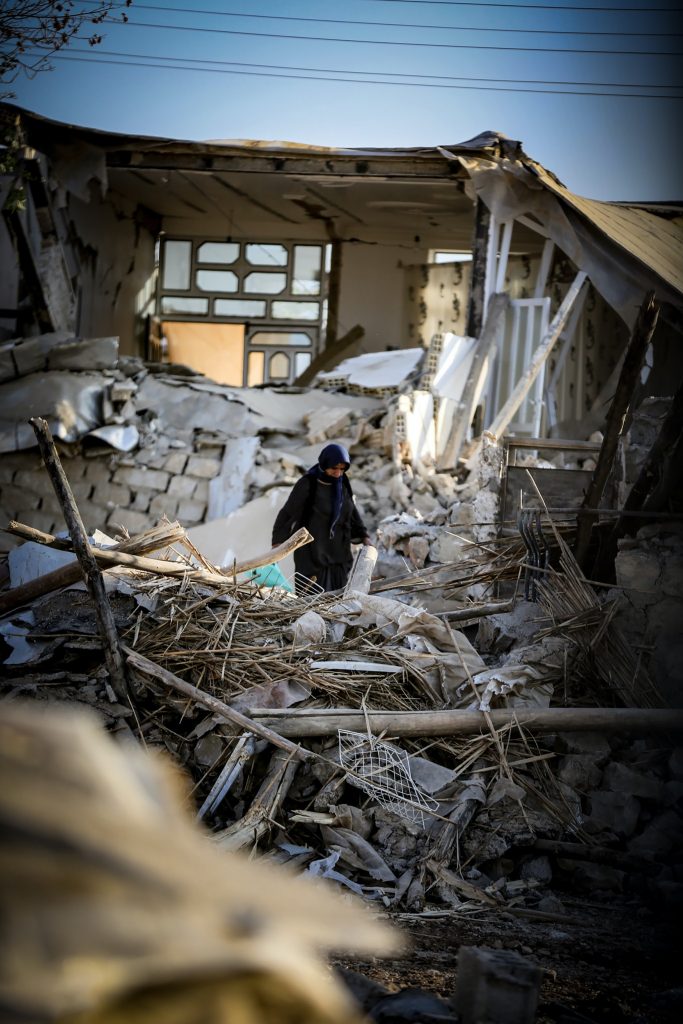Between 1998-2017, earthquakes caused nearly 750,000 deaths globally, more than half of all deaths related to natural disasters.
Explore health-relevant side events, news and resources from the 2025 UN Climate Conference.
Health at COP30 >Geological hazards, including volcanoes, earthquakes and landslides, can be dramatic and violent events with far-reaching and devastating impacts. Impacts on human health can still be felt years after the event has actually occurred.
Between 1998-2017, earthquakes caused nearly 750 000 deaths globally, more than half of all deaths related to natural disasters. More than 125 million people were affected by earthquakes during this time period, meaning they were injured, made homeless, displaced or evacuated during the emergency phase of the disaster.1 1WHO: EarthquakesIn the same time period, landslides affected an estimated 4.8 million people and caused more than 18 000 deaths.2 2 WHO: Landslides
For information on volcanic ash and its impact on air quality and human health, visit our air quality page.

Between 1998-2017, earthquakes caused nearly 750,000 deaths globally, more than half of all deaths related to natural disasters.
Between 1998-2017, landslides affected an estimated 4.8 million people and caused more than 18,000 deaths.3 3WHO: Landslides
Earthquake is a term used to describe both sudden slip on a fault, and the resulting ground shaking and radiated seismic energy caused by the slip, or by volcanic or magmatic activity, or other sudden stress changes in the Earth.4 4USGS via UNDRR/ISC Hazard Information Profiles: Supplement to UNDRR-ISC Hazard Definition & Classification Review: Technical Report
Landslide is the downslope movement of soil, rock and organic materials under the effects of gravity, which occurs when the gravitational driving forces exceed the frictional resistance of the material resisting on the slope. Landslides could be terrestrial or submarine.5 5Varnes ,1978 via UNDRR/ISC Hazard Information Profiles: Supplement to UNDRR-ISC Hazard Definition & Classification Review: Technical Report
![]()
Tephra is a collective term for fragmented magma and old (i.e., preexisting) rocks ejected into the atmosphere from volcanic vents during an explosive eruption, irrespective of size, composition and shape.6 6BGS via UNDRR/ISC Hazard Information Profiles: Supplement to UNDRR-ISC Hazard Definition & Classification Review: Technical Report The term ‘volcanic ash’ refers to the finest particles of tephra (less than 2 mm diameter).
A lava flow or lava dome is a body of lava that forms during an eruption, or main eruptive episode. Lava flows are outpourings of fluid, relatively low-viscosity molten rock, whereas a lava dome is a pile of relatively viscous lava that cannot flow far from the vent.7 7Calder et al., 2015; Kilburn, 2015 via UNDRR/ISC Hazard Information Profiles: Supplement to UNDRR-ISC Hazard Definition & Classification Review: Technical Report
Ballistics comprise fragments of magma and old (i.e., pre-existing) rocks ejected during an explosive eruption at variable velocity and angle on cannon ball-like trajectories; they are not entrained within the volcanic plume and are dispersed in proximity to the vent (typically <5 km).8 8adapted from Biass et al., 2016 and Bonadonna et al., 2021 via UNDRR/ISC Hazard Information Profiles: Supplement to UNDRR-ISC Hazard Definition & Classification Review: Technical Report
Geological hazards commonly occur in an area with high tectonic activity in the Pacific Ocean known as the ‘Ring of Fire’, which runs for 40,000 km. 75% of the Earth’s volcanoes are located along the Ring of Fire, and 90% of earthquakes occur here.
Landslides are more widespread than any other geological event, and can occur anywhere in the world. They occur when large masses of soil, rocks or debris move down a slope due to a natural phenomenon or human activity, and can accompany heavy rains or follow droughts, earthquakes or volcanic eruptions. Mudslides or debris flows are also a common type of fast-moving landslide.9 9 WHO: Landslides
Earthquakes
Health impacts of earthquakes vary according to the magnitude of the earthquake, the nature of the built environment (such as poor housing or urban slums), and the secondary effects of the earthquake, like tsunamis or landslides. Earthquakes can have immediate and long-term impacts on health.
Immediate health impacts include:
Medium-term health impacts include:
Earthquakes can also damage health facilities and transportation, which can disrupt service delivery and access to care. Health workers may not be able to reach health facilities that are still functional and medical supplies may be lost.10 10WHO: Earthquakes
Landslides
Landslides can cause high mortality and injuries from rapidly flowing water and debris. The most common cause of death in a landslide is trauma or suffocation by entrapment.
Broken power, water, gas or sewage pipes can also result in injury or illness in the population affected, such as water-borne diseases, electrocution or lacerations from falling debris. People affected by landslides can also have short- and long-term mental health effects due to loss of family, property, livestock or crops.
Landslides can also greatly impact the health system and essential services, such as water, electricity or communication lines.11 11 WHO: Landslides
Earthquakes can strike suddenly and without warning, and can result in the ground shaking, soil liquefaction, landslides, fissures, avalanches, fires and tsunamis. The extent of destruction and harm caused by an earthquake depends on:
Impacts occur through multiple avenues:
Climate change and rising temperatures are expected to trigger more landslides, especially in mountainous areas with snow and ice. As permafrost melts, rocky slopes can become more unstable resulting in a landslide.12 12 WHO: Landslides
It is crucial that countries work to mitigate, prepare and respond to earthquakes, landslides and other geological hazards. This includes:13 13WHO: Earthquakes
Research
EN
Research
EN
Research
EN